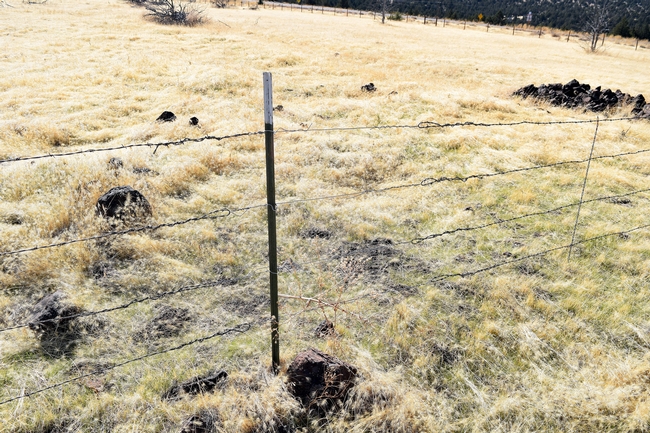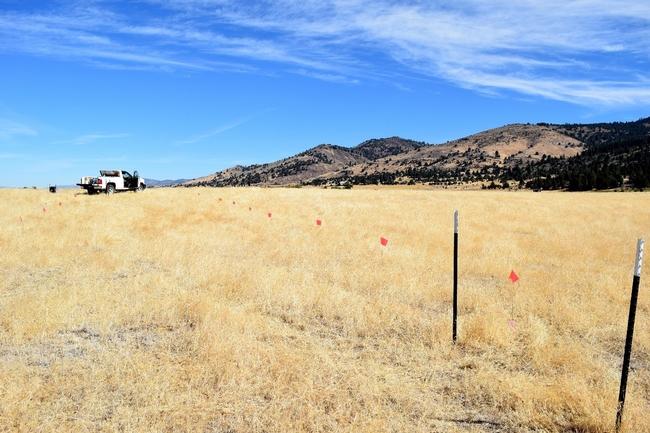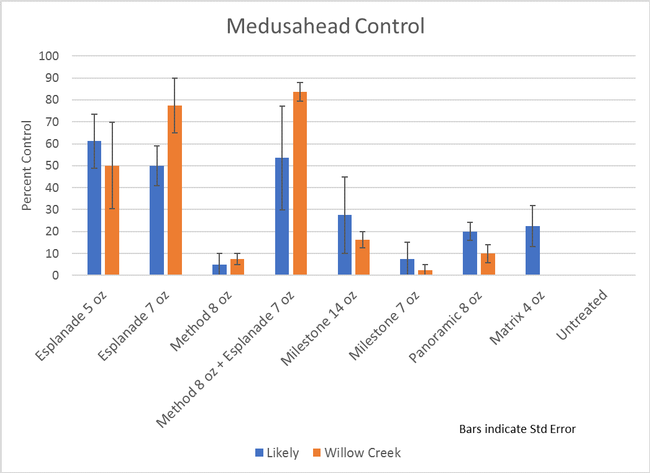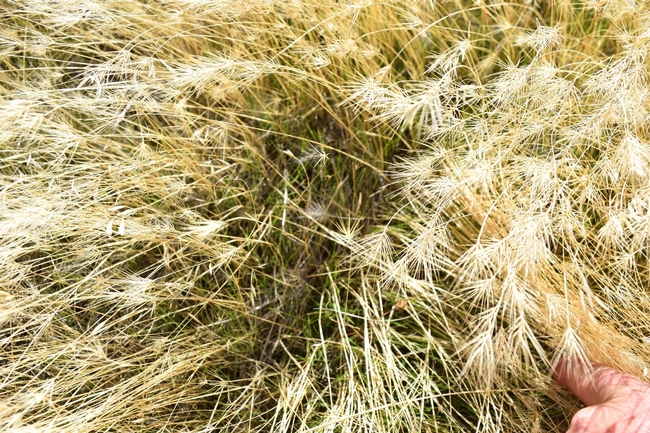I wanted to share some initial results from some medusahead trials I implemented this past year. Most of you are probably familiar with the invasive winter annual grass medusahead. If you follow this blog there have been numerous medusahead postings over the past years.
Now before I get going I wanted to point out this wonderful resource, The Medusahead Management Guide! It was published by the Weed Research Information Center in 2014, authored by Guy Kyser, Joseph DiTomaso, Kirk Davies, Josh Davy and Brenda Smith. There is a plethora of good information in this management guide and I encourage you to take a gander at it!
Link: http://wric.ucdavis.edu/publications/MedusaheadManagementGuide_pub_2014.pdf
I work up in the perennial grasslands of California. Some medusahead control techniques effective in annual grasslands are not as effective in perennial grasslands. For example, burning in the late spring/early summer has been effective to reduce medusahead in rangelands at lower elevations (Kyser et. al 2014 p.24). But at higher elevation perennial grasslands, medusahead populations have been shown to have variable responses, where sometimes populations even expand (Kyser et. al 2014 p.26).
(Photo one: Medusahead on the Modoc Plateau typically grows on heavy clay soils with lots of rocks!)
Imazapic (plateau, panoramic, etc.) has been shown to be a relatively good tool for medusahead control in perennial rangelands. Last year I attended a workshop where Kirk Davies described some of the success they were having in Oregon using prescribed fire in combination with imazapic and seeding. In their studies, they successfully established populations of crested wheatgrass, in place of medusahead. However, imazapic is not currently a registered herbicide in California, and therefore cannot be purchased or used in the state.
One of the herbicides I was interested in testing is indaziflam. The trade names are Alion in tree crops, or Esplanade in noncrop/vegetation management. It is an Alkylazine herbicide which inhibits cellulose biosynthesis and is in the Weed Science Society's mode of action group #29. Research in Colorado has shown indazilflam works very well on cheatgrass, where three year cheatgrass control has been observed with a single application. Additionally, many perennial species appear to be tolerant in the trials which have been conducted. Just a few weeks ago at the California Weed Science Society meeting, Harry Quicke from Bayer gave an interesting presentation highlighting the work which has been done with indaziflam. Some of the trials on cheatgrass in Colorado even showed good control when applied directly to the litter layer in late summer or fall before any cheatgrass germination occurred. One BIG downside of Esplanade is that currently there is no grazing label for use.
I have set up some trials to test Esplanade on medusahead, along with other herbicides which have been shown to have some pre-emergent activity. The other herbicides were Milestone (aminopyralid), Method (aminocyclopyrachlor), Panoramic (imazapic), and Matrix (rimsulfuron). I have a couple of different medusahead trials with these compounds, but I wanted to share the initial results from one of them which was implemented this fall.
(Photo two: Plots at Willow Creek Ranch in September)
Two sites were selected, one just south of Likely, California, in Lassen County and one just east of Willow Creek Ranch in Modoc County. Both sites had high populations of medusahead, with some remnant perennial grass populations intermixed. We were interested in seeing if herbicide application could control the medusahead while releasing the remnant perennial grass communities, like had been achieved in Colorado with cheatgrass. Litter was collected, dried and weighed from both of the sites. The Likely site had 120 grams of litter/meter^2 where the Willow Creek Ranch had 170 grams' litter/meter^2. Herbicide plots were 10*20 ft, laid out in a randomized complete block replicated four times at each sites. At the time of application in September, no medusahead had germinated and applications were made over the top of the litter layer from the previous growing season. Initial visual control ratings were collected in early November after medusahead had germinated (Figure one). Most medusahead seedlings were in the 1-3 leaf growth stage when control ratings were taken.
(Figure One: Visual control ratings after medusahead germination in November)
There was a lot of variability in medusahead control within individual treatments. However, none of the herbicide treatments resulted in acceptable control, as there was medusahead growing in all treated plots. Treatments including Esplanade had the greatest level of control ranging from 50 to 80%. Where Method, Milestone, Panoramic, and Matrix offered very little medusahead control. Overall, initial observations indicated none of the treatments were effective.
Well, what happened? I was hoping we might see similar results to the studies conducted on cheatgrass, but that was not the case. Greenhouse trials have shown medusahead is sensitive to Esplanade, however, in this instance within the field we did not get control. If I were to guess why control was ineffective, it would have to do with herbicides being caught up in the litter, and rains not successfully incorporating the products before germination.
On another note, over the past year I have gotten a lot of questions from people interested in controlling medusahead with Milestone. Milestone at 14 oz/acre has been shown to be an effective preemergence herbicide treatment at numerous locations within California (7 oz/acre is the maximum broadcast rate, but 14 oz/acre can be used for spot treatments) (Kyser et al 2012). I was unaware of anyone who had used Milestone at 14oz to control medusahead up on the Modoc plateau, so it was included in the study. Interestingly, very little control was observed in these trials, unlike other work which has shown it to be very effective at other locations.
(Photo Three: Healthy Medusahead under the litter layer in November. Photo from the Likely site in a plot treated with Milestone at 14 oz/acre)
I will be visiting these sites and collecting control data throughout the 2017 growing season. The medusahead was still very small at this assessment and control may be different come spring. It will also be interesting to observe the perennial grass response coming out of dormancy. Even though the trials were unsuccessful, I wanted to share these initial results because knowing what doesn't work can be valuable in its own right!
References
Kyser GB, DiTomaso JM, Davies KW, Davy JS, Smith BS (2014) Medusahead Management Guide for the Western States. University of California, Weed Research and Information Center, Davis. 68 p. Available at: wric.ucdavis.edu.
Guy B. Kyser, Vanelle F. Peterson, Josh S. Davy and Joseph M. DiTomaso Rangeland Ecology & Management, Vol. 65, No. 4 (July 2012), pp. 418-425.



